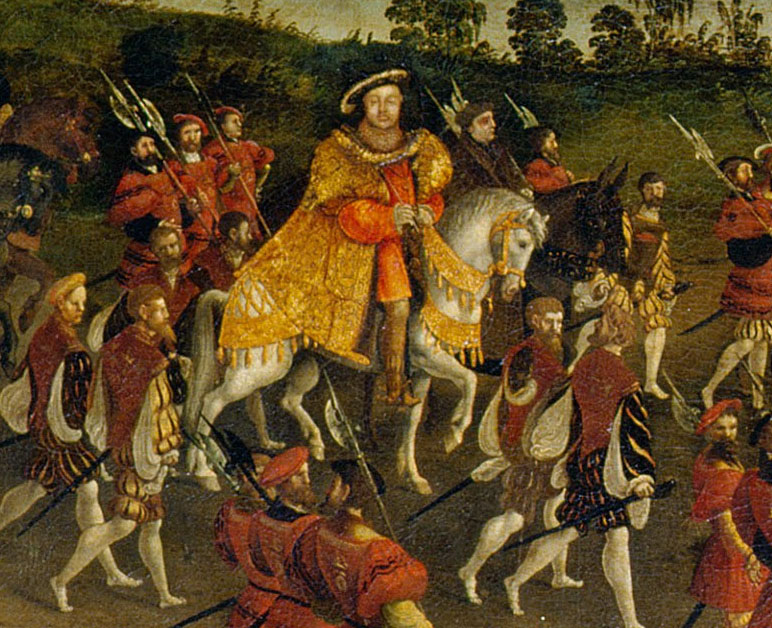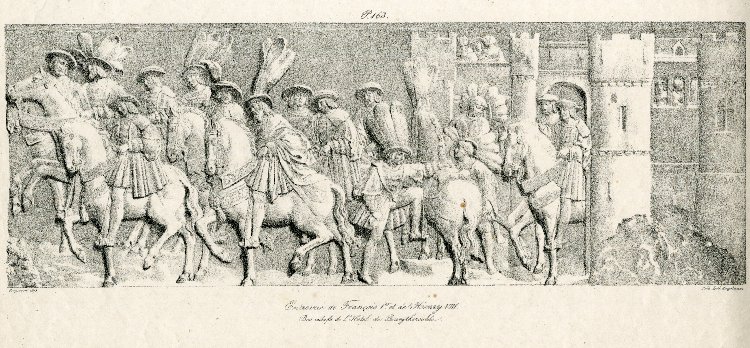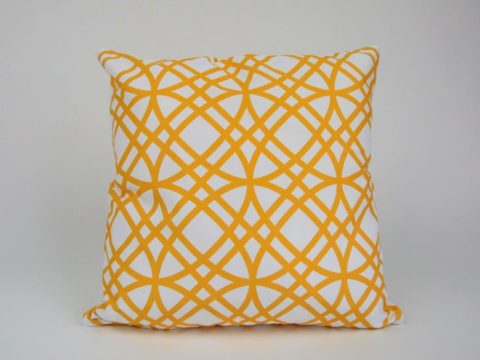Meeting of Kings
June 1520
Chapter 3 : Preliminary Courtesies
Early on the morning of 31 st May, Henry and Katharine left Dover, arriving at Calais at about 11am where they stayed until 4th June, when they moved to Guisnes.
Events began that same day as Cardinal Wolsey set forth to meet King Francois. He was preceded by a hundred archers of the guard and fifty gentlemen of his household, clothed in crimson velvet with chains of gold, bareheaded, bonnet in hand, and mounted on magnificent horses richly caparisoned. Then followed another fifty gentlemen ushers, also bareheaded, carrying gold maces with knobs as big as a man's head; next a cross-bearer in scarlet, supporting a crucifix adorned with precious stones.
Four grooms came next, with gilt bâtons and poleaxes, in tunics of crimson velvet with the Cardinal's arms embroidered in gold and their plumed bonnets in their hands. Finally, Wolsey, riding on his accustomed mule, which was also trapped in crimson velvet with gold stirrups and studs.Following the Cardinal were other clergymen and a further fifty archers, dressed in red velvet with golden roses, their bows bent. He rode in this state to Ardres, where he was met by King Francois with a fanfare of trumpets.
On Thursday, 7 th June, simultaneous shots were fired from Guisnes and Ardres – the signal for the kings to set forth. Leading the way for his master, Henry VIII, was his half-cousin, Thomas, 2nd Marquess of Dorset, bearing the sword of state, followed by the Cardinal, the Dukes of Buckingham and Suffolk and the Earl of Shrewsbury.

Henry VIII was dressed in silver damask, decorated with cloth of gold, and riding on a horse also trapped in gold. His Master of Horse, Sir Henry Guilford, led a spare mount, equally sumptuously decked out. Behind the King were his nine "henchmen" (a term that did not carry the sinister overtones it now has) in cloth of tissue.
The French were no less splendid. Riding ahead were the marshals of the French army, dressed in cloth of gold, with horses in gold trappings, followed by the Grand Master of France, the Princes of the Blood, and the King of Navarre. Then came the Swiss Guard, the gentleman, and just in front of Francois himself, the Grand Constable of France, the Duc de Bourbon. Francois was wearing a mantle of cloth of gold, covered with jewels. His sleeves were studded with diamonds,rubies, emeralds and pearls and on his head was a velvet bonnet adorned with plumes and precious stones.

Apparently, there were nerves in the English ranks. Lord Bergavenny was concerned that there were twice as many French as English and, presumably, was afraid of an ambush. The Earl of Shrewsbury urged Henry on, suggesting that " the Frenchmen be more in fear of you and your subjects than your subjects be of them".
The King gave the order to march on. At the appointed place, the armies drew up facing each other. No doubt it was a moment of tension – what if one side were planning treachery? At the signal both Kings spurred their mounts and galloped forward alone. They met and embraced whilst remaining mounted. They then dismounted, and attended only by the Cardinal and the Admiral of France, entered a pavilion for private talks.




